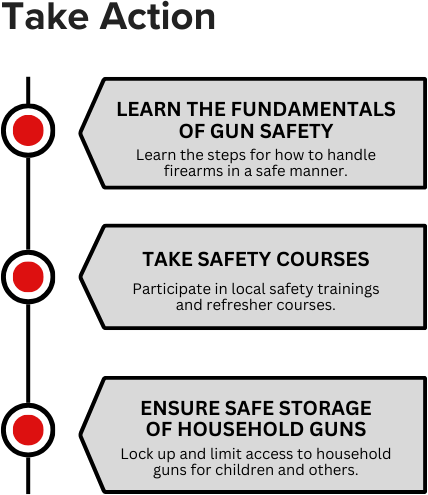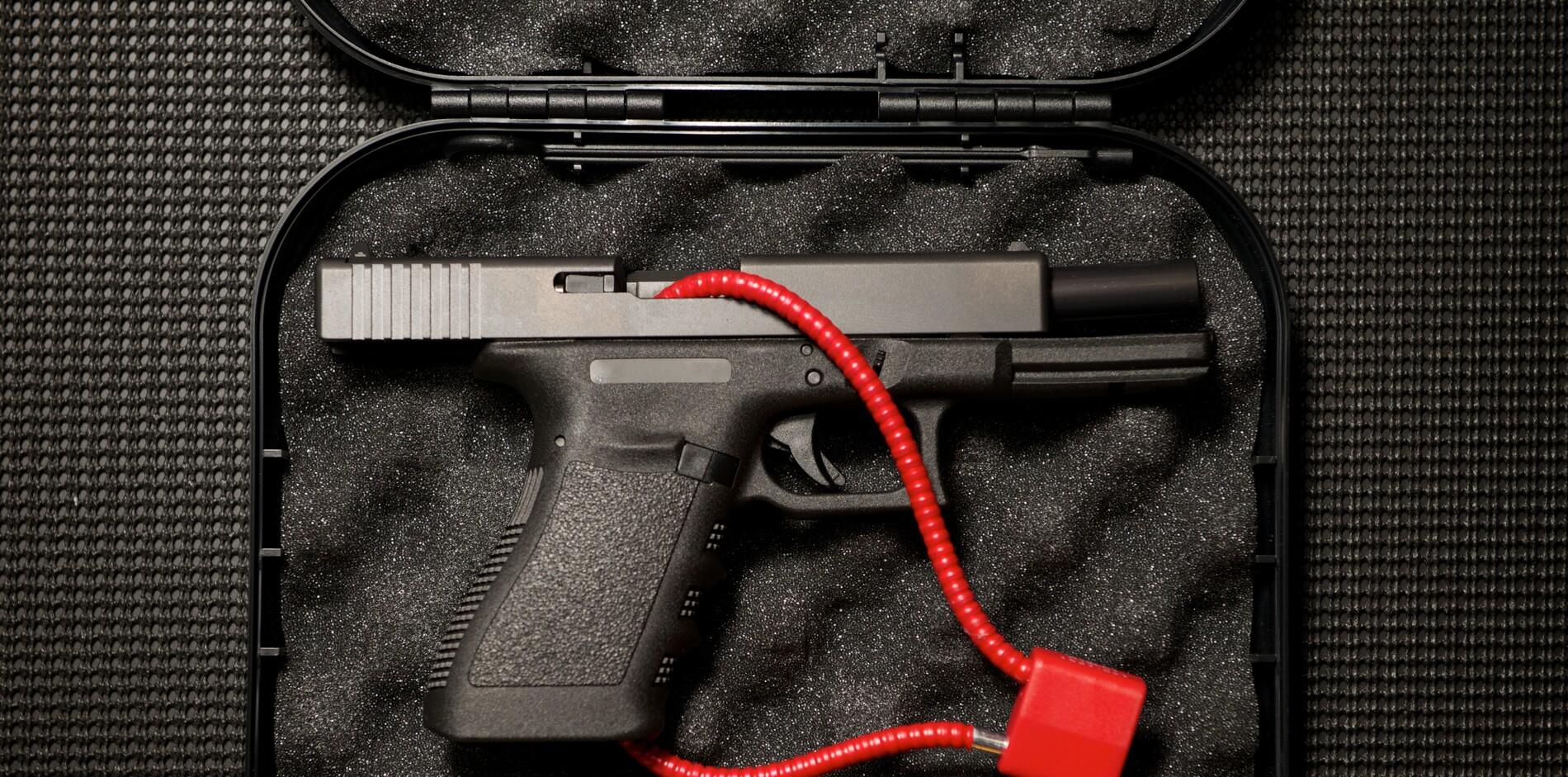Access to a Gun Increases the Risk of Injury and Death
Simply having access to a gun can increase the risk of injury, whether accidental or intentional, and death. In the United States, access to a gun has been found to:
- Triple the risk of death by suicide.
- Double the risk of death by homicide.
- Makes it five times more likely that a domestic violence victim will die by the hands of their abuser.
In Anne Arundel County, an average of 141 individuals report to a hospital or emergency room each year due to a gun-related injury. The majority of these (56%) is due to an accidental discharge, meaning the injury was due to the mishandling of a gun.

Safe Storage and Handling Can Mitigate the Risk of Harm
There are several simple steps that gun owners can take to greatly reduce the risk of harm to themselves or someone else. This includes securely storing household firearms, taking advantage of local gun safety trainings and becoming familiar with the process for disposing of or reporting a stolen gun. This toolkit is intended to provide quick resources and new information to aspirant, first-time and established gun owners.
Many Americans Own or Live in a Household with a Gun
According to a 2023 national study, 32% of Americans, approximately 100.5 million individuals, reported that they personally own a gun. That number increases to 42% of Americans when you include family members who live in a household with at least one gun. This includes an estimated 40% of households with children, or approximately 30 million children. Of these, an estimated 4.6 million children live in households with at least one unloaded, unlocked gun, which is a significant safety risk. The number of children living in a household with an unsecured gun increased 17% from 2015 to 2021.
Safe Storage Options
There are a wide range of safe storage options available to properly secure household guns that can complement your life as a gun owner. These options include a wide variety of locks and gun safes that are available for purchase online or at a gun retailer. After selecting a safe storage option that best suits your needs, follow these steps to keep yourself, family members and friends safe:
- Lock Up: Use a gun lock or safe to securely store guns. Store ammunition separately.
- Limit Access: Make sure only the gun owner has access to the keys or combinations to locked guns.
- Transfer: Consider temporarily storing your guns with a trusted individual outside of your home.
The National Shooting Sports Foundation (NSSF) has prepared a one-page document with information about how to pick Gun Storage for Your Lifestyle.
Safe Storage and Home Protection
Home protection is a primary motivator for gun owners to have easy and quick access to household guns. A Pew Research study found that 72% of gun owners report home protection as the main reason why they own a gun, followed by hunting and sport shooting. Gun safety manufacturers recognize an owner may want quick access and have developed many products that allow the owner to safety store household guns and also gain access to a gun in up to five seconds or less when it is necessary.
Safe storage is worth the extra time and effort because it lowers the risk of injury by 78% for all households and it reduces the risk of injury by 85% for households with children. Safe storage also prevents strangers from gaining access. Estimates suggest that between 200,000 to 500,000 guns are stolen from individuals each year. Proper storage of household guns ensures only the owner can gain access.
Households with Children
If children or grandchildren live in the home or are coming to visit, it is especially important to securely store household guns. Children and teens are very curious and can gain access to unsecured guns, even in households where parents or caregivers believe otherwise. Maryland's Child Access Prevention Law states that a person may not store or leave a loaded firearm in a location where the person knows or should have known that an unsupervised child or teen could gain access to it.
To learn more about gun safety for children and teens, visit the Gun Violence Intervention Team's Youth Gun Safety Toolkit.
Increase in New Gun Owners During the Pandemic
Gun sales in the United States have peaked in the past few years. In all of 2020, an estimated record 22.8 million guns were sold in the United States, which represents a 65% increase since 2019. These trends continued in 2021 to include nearly 20 million guns sold, which is lower than 2020, but higher than the pre-pandemic record of 16.7 million guns sales in 2016. Of this recent spike in gun sales, approximately 1 in 5 sales were to a first-time gun owner. A 2017 Pew Research study found that 66% of gun owners own more than one gun and 29% own five or more. These percentages are expected to have increased during the pandemic.
Considering Gun Ownership?
If you are considering purchasing a gun, there are several factors for you and the members of your household to consider. The National Shooting Sports Foundation (NSSF) offers a short one-page guide on Buying Your First Gun.
After considering your purchase, consult with household members to decide what type of gun and storage method make the most sense for you. Then, you can begin the process of purchasing a gun. Maryland requires a permit of the purchase, gun registration and owner licensing for all handgun purchases. Procuring an unregulated gun, such as a ghost gun or through an improper transfer, is illegal and will result in strict penalties.
Recently Bought a Gun?
Whether this is your very first purchase or one of several guns that you own, it is recommended that you practice shooting with the gun to familiarize yourself. Once you have purchased a handgun, you will be required to complete a Handgun Qualification License (HQL) training, with a certified trainer. Be sure to bring shooting eyewear and hearing protection, such as safety glasses and ear plugs or ear muffs.
One of the most important steps to take after purchasing a gun for the first time is to learn the fundamentals of safe gun handling. This can be done by taking a safety course at a local gun shop, practicing with a professional at a shooting range, or dry fire practice with an experienced gun owner.
Learn more about the ten commandments of gun safety:
Clearing a Gun
Whether you are finishing up at a firing range or moving a gun into safe storage at home, it's important to know how to properly clear the gun before locking and storing it. In Anne Arundel County, more than 100 individuals go to hospitals and emergency rooms due to a gun-related injury. For just over half of these individuals, the injury was due to an accidental discharge. Not ensuring that a gun is properly unloaded before training, cleaning or storing it is a significant risk for an unintentional injury to the owner or someone else.
Watch a short video on how to unload a handgun from the Citizens Safety Academy:
As a longtime gun owner, you may already be very familiar with how to safely store household guns, the fundamentals of safe gun handling, and gun safety training. A refresher on all of these topics is available in the above toolkit sections.
Transferring or Disposing of a Gun
Gifting or transferring a regulated gun through a private or secondary sale requires the same legal process as purchasing a regulated firearm, including the forms and processing fees. Gifting a gun to an immediate family member does not cost anything, but does still require a permit to purchase, gun registration and proper training for handguns. Learn more and view frequently asked questions by visiting the Maryland State Police website.
In Maryland, gun owners can temporarily transfer a gun or guns to another individual for short-term storage. This process is often used when children or grandchildren are visiting or if someone the gun owner knows may be suicidal. Owners can temporarily transfer a firearm to a friend or family member who is not otherwise prohibited from possessing a gun, to a local law enforcement department, or to a local gun shop. View the full list of gun shops participating in temporary safe storage by visiting the Maryland Safe Storage Map.
There are many reasons why a gun owner may want to voluntarily surrender a gun or guns. In Anne Arundel County, gun owners can contact County police (410-222-8610) to arrange for disposing their guns. Guns and ammunition may not be disposed of in the garbage or in a recycling collection.
Reporting a Lost or Stolen Gun
Hundreds of thousands of household guns are stolen each year in the United States. Gun locks and storage are one way to prevent someone else from accessing a gun. Maryland law requires that a gun owner must report a missing gun to local law enforcement within 72 hours of noticing that the gun has been lost or may have been stolen.
- 2021 National Firearms Study
- A Guide for Parents: Understanding Youth Mental Health and Preventing Unauthorized Access to Firearms
- A Guide to Responsible Gun Ownership
- America's Complex Relationship with Guns
- Firearms Stolen during Household Burglaries and Other Property Crimes
- Guns in the Family
- Gun Storage Practices and Risk of Youth Suicide and Unintentional Firearm Injuries
- NSSF Retailer Surveys Indicated 5.4 Million First-Time Gun Buyers in 2021
- Responsible Gun Ownership
- Safe and Secure Gun Storage: Center for Gun Violence Solutions
- What Percentage of Americans Own Guns?
- Miller M, Azrael D. Firearm Storage in US Households With Children: Findings From the 2021 National Firearm Survey. JAMA Netw Open. 2022;5(2):e2148823.doi:10.1001/jamanetworkopen.2021.48823
Stay Informed
Get notified on upcoming engagements and the latest project related news.

